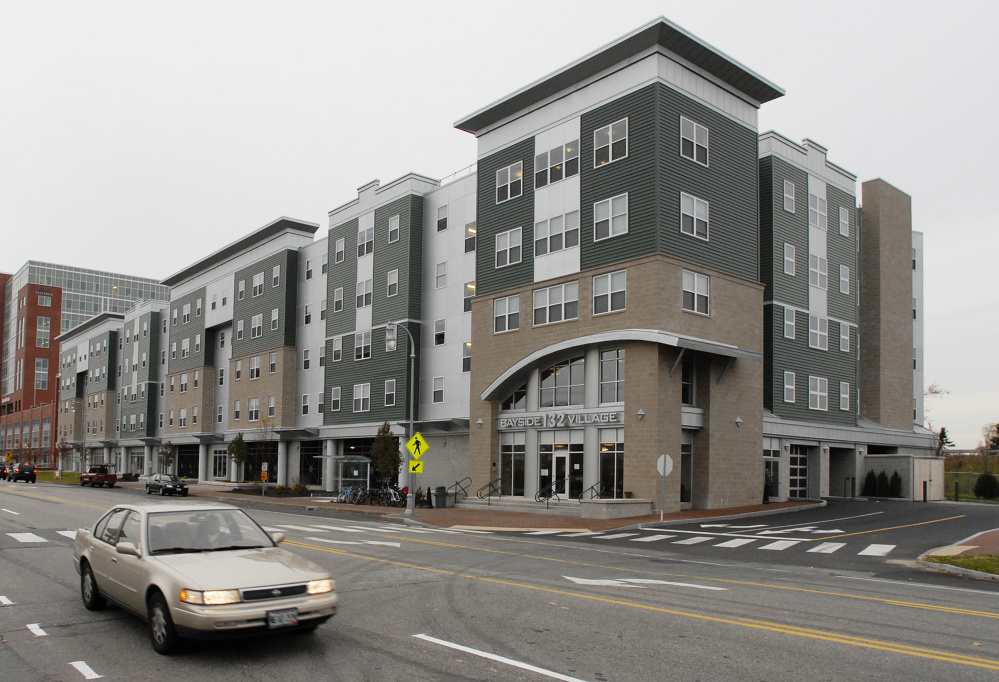Students at the University of Southern Maine will likely have a new off-campus housing option next fall in Bayside Village apartments in Portland.
On Wednesday, the University of Maine System trustees’ finance committee approved a $9.5 million, five-year plan to let USM lease two floors of the building, exclusively for undergraduate and graduate housing. Four students would live in each four-bedroom apartment, equipped with a full kitchen, for about $750 a month, which is roughly the same as the current housing rate at the USM dorms on the Gorham campus and about 30 percent lower than the market rate for the units.
The distinctive green apartments on Marginal Way, across from Trader Joe’s and visible from I-295, are less than a mile from the Portland campus.
“We have a very serious housing shortage here,” USM President Glenn Cummings told the committee. “This is a huge step forward, we hope.”
Under the proposed agreement with the owners of Bayside apartments, Blue Vista Capital Management LLC, the complex will not rent other apartments in the complex to USM students until the two floors of USM leased space is filled. Tenants on the USM floors will have special 24-hour USM security and residential assistants living there, just like an on-campus dorm. The lease agreement is for two years, with the option of three one-year extensions.
The complex was built in 2007 as a private student housing development but ran into trouble with occupancy. In 2010, it was put into receivership when the developer, Bayside Village Student Housing, defaulted on its mortgage. It was sold to Federated Cos. that year for $9.3 million, and sold again to the complex’s current owners in 2012 for $18.2 million.
GROWING HOUSING NEED
USM officials have been discussing the need for off-campus housing for about a year.
Cummings said Wednesday that Portland’s rising rents and tight housing market are putting pressure on USM students. This can even affect their ability to graduate on time – or at all, he added.
Some students, including law students, don’t come to Portland because they can’t find affordable housing. It’s also a retention issue, since undergraduates who leave the Gorham dorms and move to Portland as juniors and seniors find rent is so expensive they have to work more. That can delay their graduation, or lead to them dropping out entirely.
“We know they reduce their credit hours,” Cummings said.
USM has about 7,700 students and 1,100 beds in dorm housing on its Gorham campus, about 10 miles from Portland, which is largely occupied by undergraduate students. Years ago, USM had a 280-bed dorm off campus at 645 Congress St. The university purchased it in 1989 and sold it in 2011 for $2.2 million. At the time, officials said it was to make the residence program more cost effective.
Cummings emphasized that the Bayside arrangement is not intended to be permanent student housing.
The long-term plan is for USM to build dorms on the Portland campus. That was part of a master plan Cummings unveiled at the beginning of the school year. Under the proposal, the campus plan would eliminate Bedford Street, which bisects the Portland campus, and could eventually lead to construction of new dorms, a new professional school and two new grassy quads.
The master plan still needs to be formally presented to the school’s board of trustees.
USM officials said the plan would probably take five to 10 years to complete and cost up to $100 million, not including the cost of the professional school, which could be at least partially underwritten by the Harold Alfond Foundation.
HELP FOR THE LAW SCHOOL
The university system as a whole is emerging from years of financial turmoil. Over the last five years, the system has been sharply focused on cutting costs and increasing revenue, even as it faced declining enrollment amid a tuition freeze and a state funding freeze. In May, the trustees approved a $523.4 million budget.
Also on Wednesday, the finance committee approved giving the law school $900,000 in system funds to help close a $2 million budget gap for the budget year ending June 30, 2017. The rest of the shortfall will be made up with $663,000 from the law school’s reserves and $400,000 from the University of Southern Maine’s reserves.
After deep cuts to staff, faculty and programs, and a slight uptick in enrollment, USM was able to return $2 million in system funds this year because finances have stabilized.
The full board of trustees will vote on the law school and housing initiatives at their Nov. 13-14 meeting in Machias.
Enrollments in the law school have been declining, mirroring national trends. In 2014, total enrollment at law schools in the United States was 119,775 students, down 18.5 percent from a historic high of 147,525 in 2010, according to data from the American Bar Association.
In Maine, the law school enrollment also peaked in 2010, at 283 students, and has since declined 12.4 percent to 248 in 2015, the most recent final enrollment data available.
Dean Danielle Conway said the financial shortfall is not just a result of lower enrollment, but increased competition for those students from other law schools nationwide that are also facing enrollment pressures.
“There has been little state support for the law school for the last decade,” Conway said. “We graduate 80 to 90 students per year. This is an adequate amount of students for the requirements of the state.”
Conway said she has developed six programs to increase revenue over the next five years, without raising tuition for the law students. That includes additional certification and new programs.
Last week the law school and USM’s Muskie School of Public Service announced a new dual degree program, for a accelerated Juris Doctor degree and a Masters in Public Health degree.
Send questions/comments to the editors.




Comments are no longer available on this story